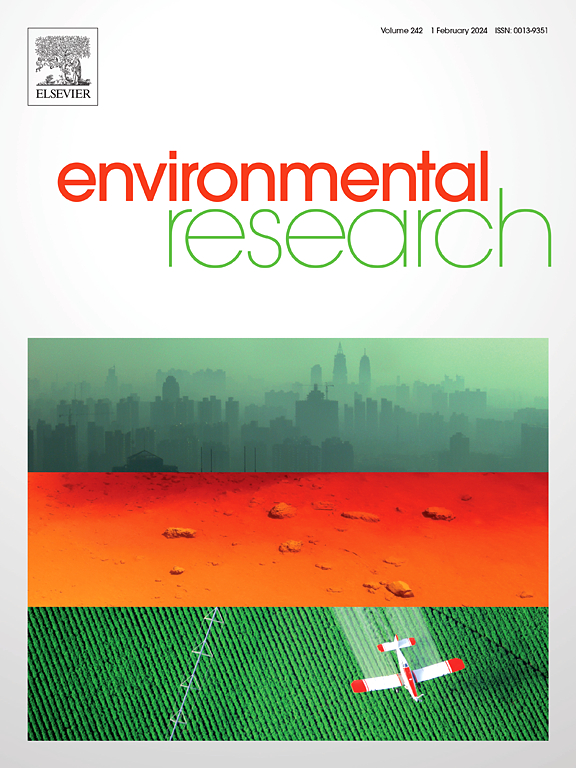Heinz Nixdorf回忆研究中环境和邻里社会经济因素对认知功能的共同影响
IF 7.7
2区 环境科学与生态学
Q1 ENVIRONMENTAL SCIENCES
引用次数: 0
摘要
可改变的物理和社会环境被认为会影响老年人的认知健康。目的采用前沿研究方法,分析环境和社会经济邻里因素对德国老年人认知功能的影响。方法在德国Heinz Nixdorf回忆队列研究中,参与者在第一次随访检查(2006-2008)时接受神经心理测试,以获得全球认知评分(GCS)。利用土地利用回归模型和化学输运模型估算了空气污染的长期暴露。道路交通噪声评价采用室外加权24小时和夜间方法。从行政数据中链接了7个社区社会经济地位(nSEP)特征。采用主成分分析(PCA)和自组织图(SOM)两种降维技术估计暴露组合对GCS的联合效应。结果共纳入3748例患者(中位年龄65岁;50.7%为女性)。单次暴露线性回归分析显示,空气动力学直径≤2.5 μm (PM2.5)颗粒物和氮氧化物暴露量越大,福利领取者比例越高,人均居住面积越小,与GCS呈负相关。在主成分分析中,方差最大的第一主成分(PC)与所有不利因子和除臭氧外的所有环境暴露浓度呈正相关。该PC与较低的GCS相关。SOM在6个暴露组中有3个暴露组与较低GCS有关。这些聚类具有低nSEP(聚类1)、高环境暴露(聚类4)和高聚集模式粒子数浓度(聚类5)的特征。我们使用两种不同的降维方法,确定了相互关联的空气污染、道路交通噪声和nSEP缺陷与较差认知功能之间的不同组合之间的关联。我们的研究结果强调了综合考虑环境和社会暴露的重要性,以系统地评估旨在减轻这些风险因素的多式联运城市干预的潜在效益。本文章由计算机程序翻译,如有差异,请以英文原文为准。
Joint effects of environmental and neighborhood socioeconomic factors on cognitive function in the Heinz Nixdorf Recall Study
Background
Modifiable physical and social environments are believed to influence cognitive health in older age.
Objectives
To employ cutting-edge methods to analyze the impact of correlated environmental and socioeconomic neighborhood factors on cognitive function in German older participants.
Methods
In the German Heinz Nixdorf Recall cohort study, participants underwent neuropsychological testing at the first follow-up examination (2006–2008) to derive a global cognitive score (GCS). Long-term exposure to air pollution was estimated by the land-use regression and chemistry transport models. Road traffic noise was assessed as outdoor weighted 24h and nighttime means. Seven neighborhood-level socioeconomic position (nSEP) characteristics were linked from administrative data. The joint effects of exposure combinations on GCS were estimated using two dimensionality reduction techniques: principal component (PC) analysis (PCA) and self-organizing maps (SOM).
Results
Overall, 3748 individuals were included (median age 65 years; 50.7 % female). In single-exposure linear regression analysis, higher particle matter with aerodynamic diameter ≤2.5 μm (PM2.5) and nitrogen oxides exposure, higher proportion of welfare recipients, and lower living area per resident were negatively associated with GCS. In the PCA, the first principal component (PC), the direction of maximum variance, was positively correlated with all disadvantageous nSEP factors and higher concentrations of all environmental exposures except ozone. This PC was associated with lower GCS. SOM revealed associations with lower GCS for 3 of 6 exposure clusters. These clusters were characterized by low nSEP (Cluster 1), high environmental exposure (Cluster 4) and high concentration of accumulation mode particle number concentration (Cluster 5).
Discussion
We identified associations between distinct combinations of intercorrelated air pollution, road traffic noise, and nSEP disadvantages with poorer cognitive function, using two different dimensionality reduction methods. Our findings highlight the importance of considering combined environmental and social exposures to systematically assess the potential benefits of multimodal urban interventions aimed at mitigating these risk factors.
求助全文
通过发布文献求助,成功后即可免费获取论文全文。
去求助
来源期刊

Environmental Research
环境科学-公共卫生、环境卫生与职业卫生
CiteScore
12.60
自引率
8.40%
发文量
2480
审稿时长
4.7 months
期刊介绍:
The Environmental Research journal presents a broad range of interdisciplinary research, focused on addressing worldwide environmental concerns and featuring innovative findings. Our publication strives to explore relevant anthropogenic issues across various environmental sectors, showcasing practical applications in real-life settings.
 求助内容:
求助内容: 应助结果提醒方式:
应助结果提醒方式:


